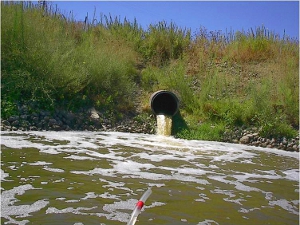Soil Science Society of America
5585 Guilford Road • Madison, WI 53711-5801 • 608-273-8080 • Fax 608-273-2021
www.soils.org
Twitter | Facebook
NEWS RELEASE
Contact: Hanna Jeske, Associate Director of Marketing and Brand Strategy, 608-268-3972, hjeske@sciencesocieties.org
Urban Impacts on Phosphorus in Streams
MADISON, WI, JULY 11, 2011 -- Although phosphorus is an essential nutrient for all life forms, essential amounts of the chemical element can cause water quality problems in rivers, lakes, and coastal zones. High concentrations of phosphorus in aquatic ecosystems are often associated with human activities in the surrounding area, such as agriculture and urban development. However, relationships between specific human sources of phosphorus and phosphorus concentrations in aquatic ecosystems are yet to be understood. Establishing these relationships could allow for the development, implementation, and evaluation of management strategies to reduce nutrient pollution.

Scientists from Washington State University-Vancouver and the University of California-Davis have investigated the link between human sources of phosphorus and phosphorus concentrations in rivers draining into California’s Central Valley. Agricultural activity and human population density data was used to estimate the annual input of phosphorus from human sources to watersheds in the Central Valley for the early 2000s. The scientists then compared these estimates with data on phosphorus concentrations in rivers draining the watersheds from 2000 to 2003. Results from the study were published in the August issue of the Journal of Environmental Quality. This study was funded by California SeaGrant, the US Geological Survey, and NASA.
The research revealed that the majority of phosphorus input from human sources was located in a very small area in most of the river basins studied. Additionally, estimates of phosphorus inputs from fertilizer and livestock manure, rather than phosphorus input from human sewage, better predicted dissolved forms of phosphorus in rivers than generic data on agricultural and urban land use types in watersheds. The form of phosphorus in rivers is important, as different forms can have different environmental impacts.
“Establishing relationships between human sources of nutrients and nutrient concentrations in rivers is of interest because they may help to develop management strategies for reducing nutrient runoff to the environment,” said Dan Sobota, who conducted the study along with John Harrison and Randy Dahlgren.
Research is ongoing at Washington State University-Vancouver and the University of California to find the link between human sources of nutrients in watersheds and aquatic nutrient levels. Further research is needed to examine how relationships between human sources of nutrients and aquatic nutrient concentrations change in other regions, and with different types of land use practices.
###
Journal of Environmental Quality publishes original research, reviews and analyses, and environmental issue articles that address anthropogenic impacts on water, soil, and the atmosphere and pertain to some aspect of environmental quality in natural and agricultural ecosystems.